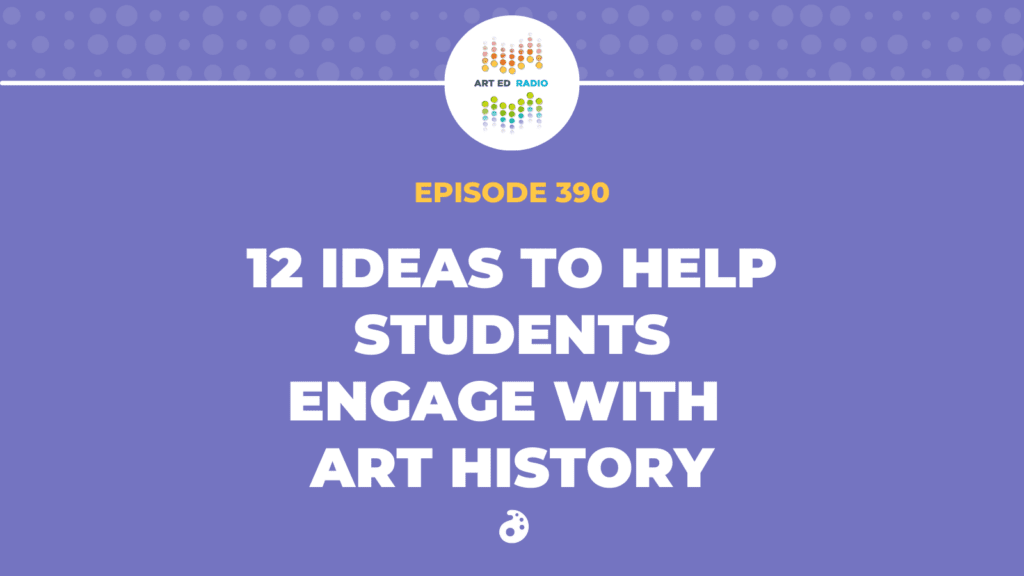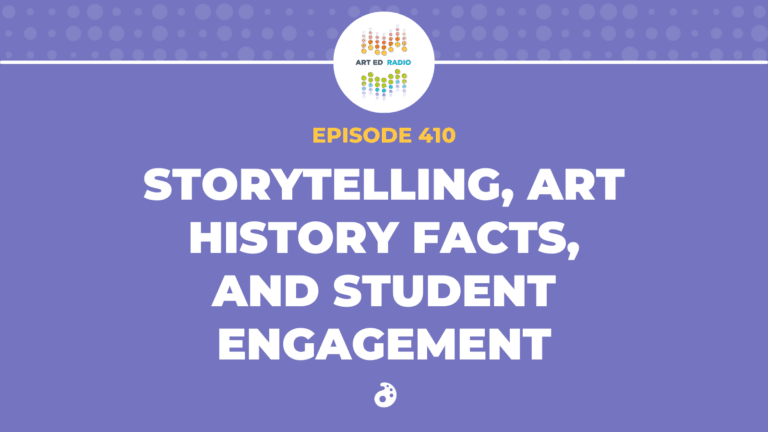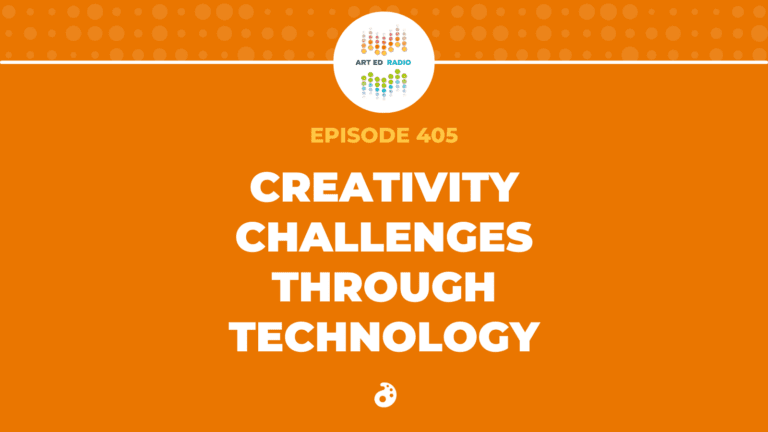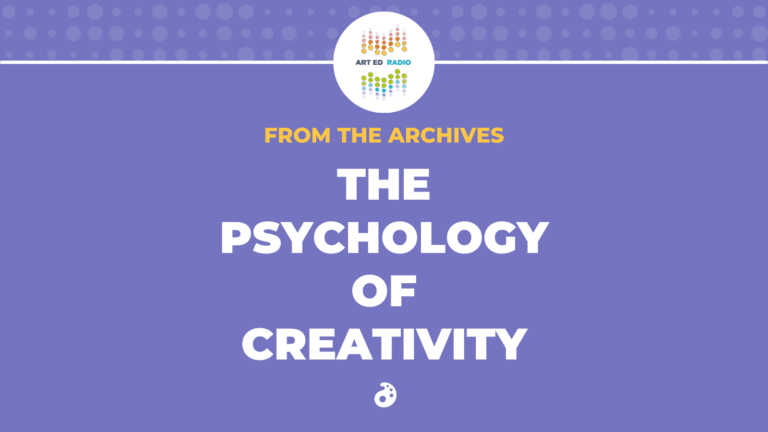We know students can be reluctant when it comes to art history, but we also know that artists from every time and place can inspire some incredible work. In today’s episode, Tim pulls a plethora of ideas from the AOEU archives on how to bring art history into the classroom. Listen as he talks about artists who can inspire your students, different ways that art history can create engagement, and how art history might be able to provide a pathway to some quality projects.
Full episode transcript below.
Resources and Links
- Tim’s Ideas: 10 Stories, Black Artists Podcast and Resource, and 144 Artists
- Artists to Inspire Your Students: 18 Contemporary Artists, 6 Diverse Artists
- Ideas for Projects: Art History Still Lifes, Art History Remix, Engaged Through Fashion
- New Ways to Engage: Personal Connections, Supporting Advanced Students, But Art History is Boring . . .

Transcript
Tim Bogatz:
Welcome to Art Ed Radio, The Podcast For Art Teachers. This show is produced by the Art of Education University, and I’m your host, Tim Bogatz. Today, I want to share with you 12 ideas to make art history more exciting in your art room. I did an episode last month on different ideas for drawing for portraits, and that seemed to go over pretty well, and people said, “Hey, I love this list of ideas. I’d love to see you do more of that.” And so I was thinking a little bit about what topic could be next. And I really like the idea of art history because first of all, I love art history. Talked about that on the podcast before. I’m a total nerd when it comes to art history. Can’t get enough of it. But there is also just a plethora of resources on the art of Ed between podcasts and magazine articles and Propex and other resources that have so much to do with art history and there’s a lot there.
And so I wanted to share a bunch of ideas that I think are really good from the archives. And so we’ll talk about some of the stuff that I’ve done before, but I also want to share just different artists that might engage your students, some different ideas that might inspire some art-making, or just ideas for things you can teach that incorporate a little bit more history. And I would love to share just some different artists that might inspire your students or different activities that might inspire your students as well. So we’ll go through all of that today. And to be honest, I know that you don’t have time to check out all of these recommendations or deal with all of the things that I’m talking about like we’re busy as teachers, but I would love for you to just kind of listen today for one or two ideas that pique your interest or you think might be worthwhile for your kids.
But before we dive into the 12 ideas, I would love to just share a little bit about how I like to teach art history. And we’ve talked about this before on the podcast, but I think it’s been a while, so I’ll make it quick though. What I would like to do is once a week, I did it every Friday. I just did art history Friday, and that was kind of our routine. Kids know that they would come in and grab their sketchbook or wherever they want to take notes, and I would show them work from a different artist every Friday. I tried to find artists that were interesting and engaging, and I would show a bunch of different images of their work. We would talk about their work in different ways, try to use a little bit of variety. We would have kids write a little bit about their work, and that could take different approaches each time, where sometimes I would have them answer specific questions or sometimes I’d have them compare to artists that we’d seen before.
Sometimes I would just have them write, “What are your impressions of this? Or what do you notice first? Or What are the biggest things that you’re impressed by here? What are the least favorite parts of your work?” Just all kinds of different prompts to get them thinking and writing or thinking and talking. Always worthwhile, especially if you have work that’s exciting or interesting for kids. And I love to have them rank artworks also. So let’s say we have an artist that we show and we say five different artworks. I have them go through, we sketch all of them that we see, and just quick sketches, 20 or 30 seconds, I always tell them, “All I need you to do is sketch it well enough that you can recognize what painting it is when you look back at your sketch.” So it doesn’t have to be great.
It doesn’t have to be detailed, just a very, very fast sketch that captures the basic of the artwork. So they can look back at that sketch and say, “Oh yeah, those Monet’s water lilies,” or, “Oh yeah, that’s that Kehinde Wiley portrait,” whatever the case may be, just good enough that they can see that. Then they have their notes and then there’s so much you can do with that. But let’s say we were looking at five paintings and they would sketch each of those five, and then I would ask them to rank them one through five. I love having them make decisions and talk about, “This is my favorite, followed by this one. This is my least favorite.” And that can lead to so much more discussion. And so anyway, just a lot of options. I would try and like I said, always use interesting artists.
And then I always like to have some kind of discussion or writing or ranking that can kind of help them do a little bit more thinking, get a little bit more engaged with the work. And I think those are important skills that they can help develop. So we did that every week, and sometimes it would take 10 minutes, sometimes it would take 20 minutes. It just depends on how things are going, but once you get into that routine, it can be really easy. And so anyway, that’s just the simplest way I think, to teach art history. But there’s so many different ways that you can engage with contemporary artists, with historical artists and use that for inspiration or use that for engagement or just for creating lessons that work for your students. There’s so much out there that you can do.
So first few ideas. First three ideas are just ideas that I’ve put together myself, things that I’ve done that I think are helpful or can be helpful for you. First one is there’s an article, and by the way, I’m going to list a ton of articles and podcasts and other resources. I will try and link to as many of them in the show notes as possible today. One more caveat while we’re doing this. I think I’m going to mention Melissa Purtee three or four times. So Melissa, thank you for all of your awesome stuff. I feel like I recommended her book to two different people in the past couple of weeks. And then I found three or four different articles of just great, great ideas with art history. So shout out Melissa Purtee before we dive in.
But anyway, three ideas here that I wanted to share from my personal archives. One of them is an article that I wrote a while ago called The 10 Stories from Art History or 10 Weird and Wild Stories from Art History that Your Students Will Love, something along those lines. And it just shared all sorts of my favorite stories from Salvador Dali to Frida Kahlo to Cai-Guo Qiang, so many different artists and so many different stories that are really engaging. And then I link to all of the stories so you can read them for yourself and see what you may or may not want to share with your students.
Second idea, a few years back, I put together a list of 17 contemporary black artists, and I did an entire podcast about that. We created an entire resource with all of these artists’, names, descriptions, talking a little bit about their work, how your students might engage with it. It can be an awesome reference if you’re looking for that. So we’ll make sure that we link to both of those. And then the third thing that I wanted to share with you, going back to that idea of how I teach art history, showing a different artist every week, I once upon a time put together a resource with 144 different artists. And so my thinking was that let’s say you have 36 weeks in the school year and you need to teach art history 36 times, and then you have a student for four years. If you go through this entire list of 144 artists, you could show a student a different artist for every week of their high school career.
So anyway, it’s a good mix of historical and contemporary artists. Probably a few that you may or may not have seen before or heard of a few that I had to research, but I thought were interesting. But it’s just a long, long list of different artists that you can look up. So you really never run out. If you’re somebody who’s looking for variety, that may be a good resource for you. Those are just three of mine that I think are worthwhile or think are fun or think that might be worth sharing.
All right, next category. These are three articles that I think help engage students. So these are artists that might engage your students. First article is called 18 Incredible Contemporary Artists that Your Students Will Love by… Guess who? Melissa Purtee. She wrote this a few years back, and she has a great list of artists with images. So you can see what captures your attention, what you think might capture your student’s attention. A quick description of each of the artists. And it’s a huge variety from sculptors to installation artists, to street artists, to people just working with unconventional materials and people creating giant sculptures.
And yeah, just a great list of awesome artists. So you can scroll through, like I said, see what captures your attention, read just a little bit about them, and then check out their website or another reference that can help you figure out what you’re seeing, what you may want to share with your students. It’s a great place to get started if you’re looking for unique artists, if you’re looking for contemporary artists.
Second is a more recent article from Josh Chrosniak, a friend of the pod. And he wrote an article called Don’t Miss These Six Contemporary Artists: Educating Through Art History. And he has six artists in there that are perhaps a little more well-known like Anselm Kiefer, Ai Weiwei, Kara Walker, Kehinde Wiley, all spectacular artists. And Josh does a great job of describing the artist, describing their work, and talking about how it may be able to inspire students, things you may want to talk about with them. And then he just talks about how you can find these artists, incorporate them into your curriculum, and just they’re doing cool things, they’re doing exciting things, and they’re probably going to resonate with your students. So I think that that fits well in the categories of artists that might engage your students.
And then also Chelsea Solano wrote an article that said Artists That Art Teachers are Grateful For. And so she put down a list, I think there’s 10 in there of really good artists that I think are pretty well known. And she talks about reasons why each of those artists resonate with art teachers or reasons that art teachers like to share or talk about those particular artists in their classroom. So I think that’s a fun one. She kind of makes that connection piece for you makes that engagement piece clear for you. So you can just look at that artist and say, “Oh yeah, when I’m talking about this subject, this artist is going to work well.” And so that’s another one that I think is worth checking out.
All right, moving on to our next category. We have six ideas down, six more to go. These are ideas that might inspire your students, and I think that all of these could lead to some quality art-making opportunities for you. First up is Debi West, and she wrote an article called How to Use Art History to Take Your Still-Life Studies to the Next Level.
And I think this is a really cool idea because everybody’s teaching still-lives most likely, they may or may not be exciting, but in this resource, Debi shares not only some good ideas, some strategies for teaching still-lives but then also some good strategies for incorporating art history and taking those still lives to the next level. So it’s basically a project where students are creating two still lives, one is very traditional, and then the second one is based on the work of a famous artist. She leaves some tips there just talking about the setup, the process. She has a good list of objects that are good to draw, can lead to some dynamic compositions talking about cloth folds and glass and metal and foliage and wood. Maybe you want some mirrors in there, maybe some musical instruments. Just a long list of possibilities, which I think are really cool.
She talks about how you help students find and create a good composition, some tips on creating that first still life. And then the cooler part of this is ideas on how to bring art history into this and help kids, like I said, take that still life to the next level. So go ahead and check that out if that piques your interest. Again, it’s called How to Use Art History to Take Your Still-Life Studies to the Next Level. So awesome article from Debi West there.
Second one on ideas that may inspire students to do some art-making. This is from Melissa Purtee. Again, it’s called Engaging Your Students From Day One With An Art History Remix. And this is incorporating art history and creative thinking. And so she just talks about how you can put your students into groups and assign them historical works and then talk to them about how they’re going to remix a painting.
And so she’s just asking them to create a reimagine version of the artwork that either adds to the original or changes the meaning. She uses Kehinde Wiley as a great example of this where you can look at the old Napoleon painting and then you look at the contemporary Kehinde Wiley one where he’s got the composition, but he’s changed the background, he’s changed the subject matter and made it much more modern, much more engaging. And I think that students respond well to that, and it kind of clarifies exactly what you’re looking for with that. And then Melissa talks about the guidelines that she gives to students for the artwork, and then giving them the push they need to start brainstorming, start putting together some different ideas on how they can remix whatever work they’ve been assigned, and then they can create and share their work. So there’s some very cool strategies, a great exercise for creative thinking, helping kids do some different things, show them the possibilities that are out there for creating work and doing something interesting with art history. Really like that one. I really think that’s worth checking out.
And then finally, more recently, I think earlier this year actually, Jackie Myers wrote an article called How to Keep Your Students Engaged in Art History Through Fashion, which I think is a really fresh and fun and kind of cool way to get those discussions going, just thinking about fashion. So she talks about how you can select an artwork that you want to talk about. She’s got suggestions, specific suggestions for beginners, for intermediate level. And then when you share the artwork, she talks about how you can get kids engaged by noticing fashion-related artworks and noticing all the different types of fashion that might be in a particular one. And then really diving down a little bit more, getting those critical thinking skills going, and trying to extrapolate some meaning from what they see in fashion.
She goes in-depth with how you can do that, things you can focus on, how you can connect it to the elements of principles, and just do so much more with it. So I think all of that is worthwhile. And then she gives a couple of suggestions for extensions if you want to go even further and check out some of those ideas there. I think it’s a really interesting way to get kids to engage and then those extensions are a great way to get them creating as well.
And then finally, the last category here is just artworks or art history that can bring some life to your classroom. And so first one here is another article by Jackie Myers from last year called, But Art History is Boring. And she is just talking about how you can bring all sorts of different types of thinking and all sorts of different strategies with both past and present artworks and just saying, “Hey, it’s tough to capture kids’ attention, but if you have the right engaging approach, you can do some cool things.”
And one thing she says in there that really resonates with me is once you have your research done, just let your passion and your enthusiasm for art history shine through during instruction. And she has some… I think it’s a list of 10 different ways to add art history to your curriculum, talking about choosing artists to teach in each unit. She gives you suggestions for really engaging artists. She talks about using books, using artist biographies, connecting with student interests, giving you ideas for students who are passionate about social issues, check out these artists or these ideas, students who love video games, check out this artist or this installation. And it just gives you a ton of different ideas for art history, whether you’re bringing it in piecemeal, whether you’re using it to inspire some artworks, whether you’re doing some comparisons, some writing, some discussion, all sorts of great ideas. So that’s a good one that can really tie in and do some good things in your classroom.
Okay, the second one, Melissa Purtee, one more time. This is an older article, but I still think the ideas are very good. It’s called Four Ways to Help Students Personally Connect With Art History. She starts off by talking about how we decide which artists we’re going to show our students. And it usually comes down to the artists we learn about in school, the artists, we as teachers are ourselves like, or the artists that connects with whatever lesson that we’ve already planned. And Melissa encourages you to go beyond those. And so she turns the question back to us as teachers and asks, “What do you want your students to learn from the artworks that they’re seeing?” And so, I think that’s a good question. I think that’s a good one for everyone to ask themselves.
And she talks about how she wants to show artists that connect with her students. She wanted the artists that she chose to be relevant to her students. And I think that’s a great idea. I think that’s a great goal to shoot for. She just talks about showing multiple examples, including current contemporary working artists, and then let students decide too. There are all kinds of different ideas of ways you can do that, ways you can find and incorporate different artists. She encourages you to do exactly that. And so I think that’s something that’s worth thinking about and something that is worth exploring.
And then finally, last article that I want to point out, this is from Janet Taylor. She wrote an article called 7 Contemporary Artists to Support Advanced Students. This was inspired by the expectations of the new AP Art and Design Portfolio that came out just a couple of years back. And there’s a lot there where we’re trying to get to student understanding, and there’s a lot there about in inquiry sustained investigations and kind of the questions that students are asking about what they’re doing, what kind of questions they’re asking to guide the creation process.
And then also what kind of questions can you talk about when it comes to synthesis of materials and process and making thinking visible, revising work. There’s so much there, but this article covers it all, which I think is really, really valuable. I know a lot of teachers are still struggling with this sustained investigation and the requirements for the new portfolio. So if that is you, this is a great place to start. Or if you teach AP and are just looking for new artists or new ways to look at things, Janet’s research here is great. She also has a list of artists within this article talking about Merrit Johnson and David and Mark Bradford, who I love by the way, and El Anatsui.
Just a long list of artists and she talks about the artists, she shows their work, but then also has guiding questions for their work. And those guiding questions can really show students what you’re looking for in a lot of different ways, how the artists are doing the things that the student artists also need to do as far as making thinking visible and revising their work and synthesizing their materials and capturing their process, all the things that the new portfolio is asking for. So like I said, if that works for you, if that fits what you’re doing in your classroom, I would definitely check that out and it’s a good resource that can add a little bit more. All right, so those are 12 different resources. Like I said, I’ll link to as many of them as I can and hopefully, a couple of them may work for you.
Two more things before we go. If you are a pro member with the [inaudible 00:24:17], we have two great PRO Packs, one of them for secondary, one for elementary. I created the secondary art history PRO Pack, and it just talks about why I like to have students write, what types of artists and artwork that I think engage students, a lot about higher-order thinking skills, some instructional strategies. So if 25 minutes here was not enough and you want to hear me talk for literal hours about art history, that might be a good place to go. The Elementary Art History PRO Pack was done by good friend and another friend of the pod, Lindsay Moss. It’s not hours long, but there’s enough there. It has a lot of good information. Again, instructional strategies there, but also ideas on which artists to teach, how you can best utilize outside resources, how you can teach kids about observation and discussion, and art making that’s inspired by art history.
A lot of the stuff that we have here, she’s putting it into action, so if you’re interested, please feel free to check those out. Just a couple more resources that are available if you really want to extend your learning. But more than anything, I just hope that the 12 ideas here give you some avenues to explore some artists to incorporate into your teaching. Like I said at the beginning, you definitely don’t need to try all 12, but if a couple of things here captured your attention or your interest, I would encourage you to check out those resources or those articles, explore them a little bit more, see if they might work for you and your students, and then you have the opportunity to try something new. When it comes to art history.
Art Ed Radio is produced by The Art of Education University with audio engineering from Michael Crocker. Thank you as always for listening. I will be back next Tuesday with another episode, and I hope you can join us then.
Magazine articles and podcasts are opinions of professional education contributors and do not necessarily represent the position of the Art of Education University (AOEU) or its academic offerings. Contributors use terms in the way they are most often talked about in the scope of their educational experiences.



